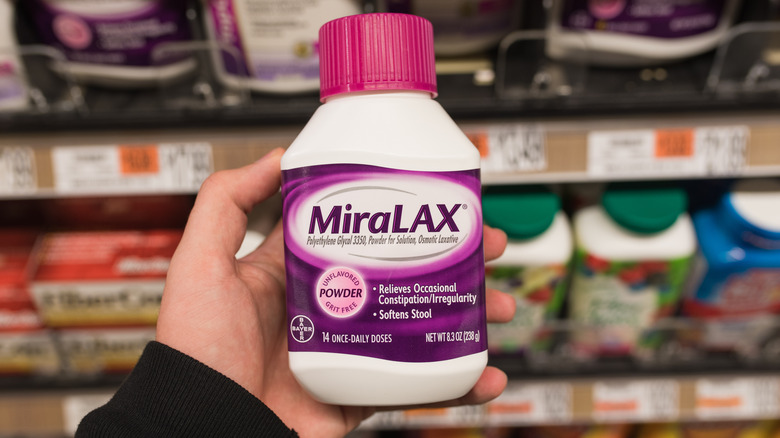This Is How Long It Takes For Miralax To Start Working
Miralax, also known as polyethylene glycol 3350, is part of a special class of medications called osmotic laxatives, which can be obtained over the counter (via MedlinePlus). It aids bowel movement, so doctors often prescribe the drug as a remedy for constipation — a common condition affecting millions of people.
Constipation is the most common gastrointestinal complaint, accounting for about 2.5 million doctor visits annually. Even though there is no set number of how many times you should expel stool, you may be diagnosed with constipation if you poop fewer than two times per week (via Healthline). Keep in mind that if you notice blood in the stool, or are vomiting, and have severe abdominal pain, it's best to seek medical attention. After all, a lack of bowel movement can lead to several complications, including anal fissures, which can cause rectal bleeding, per Johns Hopkins Medicine.
Luckily, there are various natural treatment options for constipation. Miralax, however, comes in handy as well, according to WebMD. But if you're considering the drug, you might wonder how long it takes for Miralax to start working. Here's what we know.
It can take over 24 hours
It's crucial to understand that various factors can determine the speed and efficiency of Miralax. Generally speaking, the drug works by holding and softening water in your stool, increasing the number of bowel movements (per WebMD). Therefore, unlike most laxatives, Miralax doesn't typically cause a sudden need to defecate (via Drugs.com). Rather, you can expect a bowel movement in about one to three days without any severe side effects. While there's no best time to take the drug, taking it earlier in the day might be best to prevent bowel movement while asleep.
Miralax comes as a flavorless powder in bottles or single-serve packets, explains Medical News Today. The right Miralax dose depends on various factors, including your age, medical history, or condition. As a guide, 17 grams are recommended for adults. However, this might vary from one person to another. Therefore, it's always best to consult with your doctor if you are unsure about the dosage. Keep in mind, it's essential not to increase or decrease the dosage recommended on your prescription or the manufacturer's instructions. If constipation persists after Miralax use, please consult your doctor.
Common side effects of Miralax
Like with other medications, Miralax comes with some side effects. As a stool softener, it can bloat your stomach with more gas, according to Harvard Health Publishing. Other common effects include stomach cramps, abdominal pains, excessive thirst, nausea, or an irritated feeling in the rectum (via WebMD). On the other hand, less common side effects involve seizures, muscle tremors, colon ulceration, and lip swelling, among others.
Keep in mind, those who abuse their prescriptions are more likely to experience diarrhea, as per Medical News Today. Furthermore, seniors may also be more susceptible to certain side effects than others. Please consult your doctor if you experience unexplained symptoms or severities after taking Miralax. Also, if you plan to use Miralax alongside other medications, please note that it may interact with various drugs, including acetaminophen, aspirin, and albuterol (via Drugs.com). In addition, it's important to remind your doctor about any medications you're currently taking as well. This way, they can compare the drug's benefits against its side effects and interactions before prescribing it.



